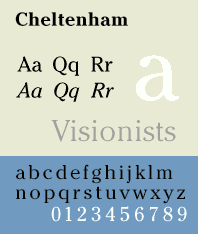Cheltenham (typeface)
 |
|
| Category | Serif |
|---|---|
| Classification | old style |
| Designer(s) |
Bertram Grosvenor Goodhue |
| Foundry | American Type Founders |
| Date released | 1903 |
Bertram Grosvenor Goodhue
Ingalls Kimball
Morris Fuller Benton
Cheltenham is a typeface for display use designed in 1896 by architect Bertram Goodhue and Ingalls Kimball, director of the Cheltenham Press. The original drawings were known as Boston Old Style and were made about 14" high. These drawings were then turned over to Morris Fuller Benton at American Type Founders (ATF) who developed it into a final design. Trial cuttings were made as early as 1899 but the face was not complete until 1902. The face was patented by Kimball in 1904. Later the basic face was spun out into an extensive type family by Morris Fuller Benton.
Cheltenham is not based on a single historical model, and shows influences of the Arts and Crafts Movement. Originally intended as a text face, "Chelt" became hugely successful as the "king of the display faces." Part of the face's huge popularity is because, as it has elements of both an old style and transitional face, a Cheltenham headline complements virtually any body type. The overwhelming popularity of the face for display purposes lasted until the advent of the geometric sans-serif typefaces of the 1930s.
The following versions were available in foundry type:
The popularity of Cheltenham continued strong right in the cold type era, and it was offered by various manufacturers under the following names:
A cold type variant ITC Cheltenham, was also designed by Tony Stan for the International Typeface Corporation, in 1975. It features a larger x-height and improved italic details. The family includes 4 weights and 2 width each, with complementary italics.
...
Wikipedia
